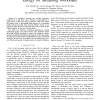Free Online Productivity Tools
i2Speak
i2Symbol
i2OCR
iTex2Img
iWeb2Print
iWeb2Shot
i2Type
iPdf2Split
iPdf2Merge
i2Bopomofo
i2Arabic
i2Style
i2Image
i2PDF
iLatex2Rtf
Sci2ools
ESTIMEDIA
2007
Springer
2007
Springer
Interposing Flash between Disk and DRAM to Save Energy for Streaming Workloads
— In computer systems, the storage hierarchy, composed of a disk drive and a DRAM, is responsible for a large portion of the total energy consumed. This work studies the energy merit of interposing flash memory as a streaming buffer between the disk drive and the DRAM. Doing so, we extend the spin-off period of the disk drive and cut down on the DRAM capacity at the cost of (extra) flash. We study two different streaming applications: mobile multimedia players and media servers. Our simulated results show that for light workloads, a system with a flash as a buffer between the disk and the DRAM consumes up to 40% less energy than the same system without a flash buffer. For heavy workloads savings of at least 30% are possible. We also address the wearout of flash and present a simple solution to extend its lifetime.
Disk Drive | DRAM | DRAM Capacity | ESTIMEDIA 2007 |
| Added | 07 Jun 2010 |
| Updated | 07 Jun 2010 |
| Type | Conference |
| Year | 2007 |
| Where | ESTIMEDIA |
| Authors | Mohammed G. Khatib, Berend-Jan van der Zwaag, Pieter H. Hartel, Gerard J. M. Smit |
Comments (0)

